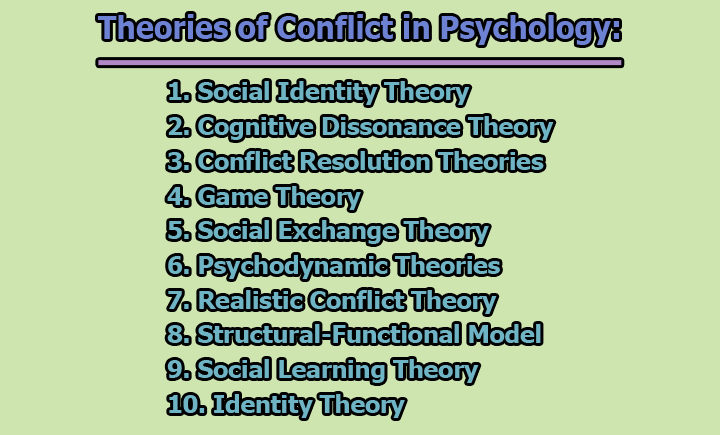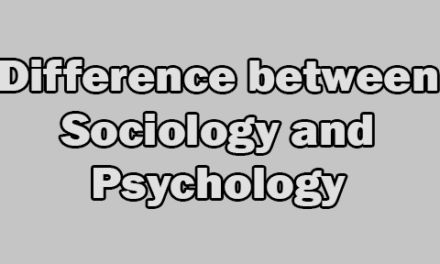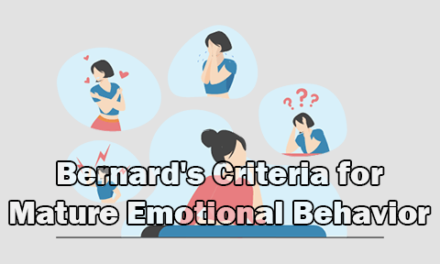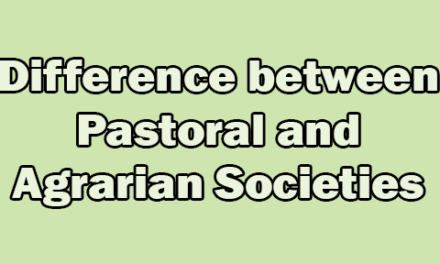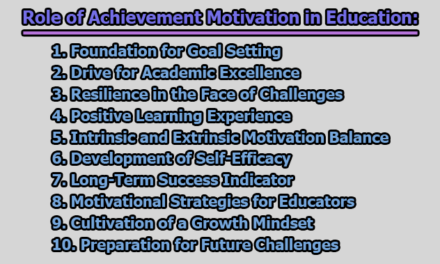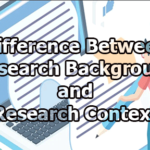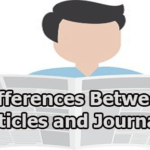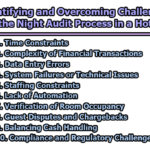Conflict in Psychology:
Conflict in psychology is a dynamic and pervasive phenomenon that plays a fundamental role in shaping human behavior, relationships, and societal structures. Rooted in differing perceptions, values, and goals, conflict emerges at various levels, from individual internal struggles to complex intergroup dynamics. Psychologists, drawing from diverse theoretical frameworks, investigate the cognitive, emotional, and behavioral dimensions of conflict, seeking to unravel its intricacies and offer strategies for resolution and transformation. In this article, we will explore the definitions, types, causes, levels, sources, and theories of conflict in psychology.
Definitions of Conflict in Psychology:
“Conflict is an inherent part of human existence, arising from the clash of needs, goals, and values, often manifesting as an intricate interplay of emotions and thoughts” (Thomas, 1976), Psychologist and Organizational Consultant.
“Conflict is the dynamic struggle that ensues when incompatible motivations, beliefs, or desires coexist within an individual, prompting a search for resolution or equilibrium” (Deutsch, 1949), Social Psychologist.
“Conflict represents the manifestation of repressed desires and unresolved tensions within the unconscious mind, influencing behavior and interpersonal dynamics” (Freud, 1920), Founder of Psychoanalysis.
“Within the cognitive framework, conflict emerges from the inconsistency between beliefs, attitudes, or values, leading to cognitive dissonance that compels individuals to seek resolution for psychological harmony” (Festinger, 1957), Social Psychologist.
“Conflict, as perceived in the context of social identity theory, materializes when individuals categorize themselves and others into social groups, fostering intergroup comparisons that fuel in-group favoritism and outgroup discrimination” (Tajfel & Turner, 1979), Social Psychologists.
Types of Conflict in Psychology:
In psychology, conflicts can be classified into different types based on the nature of the goals or choices involved. Each type of conflict presents unique challenges and dynamics. Let’s explore four specific types of conflicts:
1. Approach-Approach Conflict: Approach-Approach conflict occurs when an individual is faced with a choice between two equally desirable options or goals.
Key Points:
- The individual must decide between two positive outcomes.
- There is typically less psychological stress compared to other types of conflicts.
Example: Choosing between two job offers, both with attractive salary packages and benefits.
2. Avoidance-Avoidance Conflict: Avoidance-Avoidance conflict arises when an individual must choose between two equally undesirable options or goals.
Key Points:
- The individual faces a dilemma where both choices lead to negative outcomes.
- This type of conflict often generates significant psychological discomfort.
Example: Deciding whether to stay in a dissatisfying job or to accept a new job with undesirable conditions.
3. Approach-Avoidance Conflict: Approach-Avoidance conflict occurs when a single goal or option has both positive and negative aspects.
Key Points:
- The individual is attracted to the goal’s positive aspects (approach) while being repelled by its negative aspects (avoidance).
- Ambivalence and inner turmoil characterize this conflict type.
Example: Considering a job promotion that comes with a significant salary increase (approach) but also requires much longer working hours (avoidance).
4. Double Approach-Avoidance Conflict: Double Approach-Avoidance conflict involves two options, each having both positive and negative aspects.
Key Points:
- The individual must weigh the pros and cons of each option, leading to a complex decision-making process.
- This type of conflict tends to be particularly challenging due to the balancing act required.
Example: Choosing between two graduate programs—one with an excellent faculty but located in a city with a high cost of living and another with a less prestigious faculty but located in a more affordable city.
Common Characteristics Across Types:
- Decision-Making Struggle: All these conflict types involve a decision-making struggle where individuals must weigh the pros and cons of their choices.
- Psychological Stress: Conflict, in general, brings about psychological stress and discomfort as individuals grapple with competing desires or aversions.
- Individual Differences: The way individuals handle conflicts can vary based on personality, coping mechanisms, and their unique perspectives.
Coping Strategies:
- Information Gathering: Individuals may seek more information about the options to make an informed decision.
- Prioritization: Prioritizing goals or values can help individuals focus on what matters most to them.
- Seeking Support: Talking to friends, family, or mentors for advice and emotional support can aid in decision-making.
Understanding these types of conflicts and their underlying dynamics can assist psychologists, counselors, and individuals in developing strategies for effective decision-making and managing the psychological stress associated with conflicting choices.
Let’s delve into some common types of conflict encountered in various contexts, including the workplace and interpersonal relationships:
1. Task Conflicts: Task conflicts arise from differences in opinions, perspectives, or approaches related to the actual tasks or goals within a group or organization.
Characteristics:
- Disagreements on how to approach a project or solve a problem.
- Differing opinions on task priorities and deadlines.
Resolution Strategies:
- Open communication to clarify goals.
- Encouraging diverse perspectives.
- Establishing clear expectations and guidelines.
2. Leadership Conflicts: Leadership conflicts occur when there are disputes or disagreements related to leadership styles, decisions, or authority within a group or organization.
Characteristics:
- Challenges to a leader’s decisions or authority.
- Differences in leadership approaches or visions.
Resolution Strategies:
- Facilitating open communication between leaders and team members.
- Providing leadership training and development.
- Establishing clear leadership roles and responsibilities.
3. Work Style Conflicts: Work style conflicts emerge when individuals have divergent approaches to tasks, communication, or collaboration in the workplace.
Characteristics:
- Differences in preferred work pace or methodology.
- Varied communication styles or preferences.
Resolution Strategies:
- Promoting team-building activities.
- Encouraging flexibility and adaptability.
- Establishing clear communication channels and expectations.
4. Value Conflicts: Value conflicts stem from differences in core beliefs, principles, or ethical considerations between individuals or groups.
Characteristics:
- Disagreements on ethical decisions or values.
- Conflicting beliefs about what is right or wrong.
Resolution Strategies:
- Facilitating open discussions about values.
- Seeking common ground and shared values.
- Establishing ethical guidelines and principles.
5. Personality Conflicts: Personality conflicts arise from clashes in individual personalities, communication styles, or interpersonal dynamics.
Characteristics:
- Incompatibilities in communication or working styles.
- Personalities that clash or irritate each other.
Resolution Strategies:
- Encouraging self-awareness and empathy.
- Providing conflict resolution training.
- Facilitating team-building exercises.
6. Creative Ideas Conflicts: Creative ideas conflicts occur when there are disagreements or challenges related to innovative or creative solutions, approaches, or projects.
Characteristics:
- Differing opinions on the viability or effectiveness of creative ideas.
- Conflicts over resource allocation for innovative projects.
Resolution Strategies:
- Encouraging a culture that values creativity.
- Establishing clear evaluation criteria for creative proposals.
- Promoting collaborative brainstorming sessions.
7. Competition Conflicts: Competition conflicts arise when there is rivalry or disputes related to competition for resources, recognition, or opportunities.
Characteristics:
- Competing for promotions, projects, or attention.
- Conflicts over limited resources.
Resolution Strategies:
- Establishing fair and transparent processes for resource allocation.
- Encouraging collaboration alongside healthy competition.
- Recognizing and rewarding collaboration.
These common types of conflict underscore the diverse nature of challenges that can arise in various settings. Understanding the specific characteristics and resolution strategies for each type is essential for effective conflict management and fostering positive relationships in the workplace and beyond.
Causes of Conflict in Psychology:
The causes of conflict in psychology are multifaceted and rooted in a complex interplay of individual, interpersonal, and societal factors. Understanding these causes is crucial for psychologists, counselors, and individuals seeking to navigate, manage, and resolve conflicts effectively. Below is an exploration of the various causes of conflict in psychology:
- Individual Causes:
- Personal Values and Beliefs: Individuals hold diverse values and beliefs shaped by their upbringing, culture, and personal experiences. Conflicts may arise when these values clash, leading to disagreements and tensions.
- Conflicting Goals or Desires: Individuals often pursue different goals or desires, and when these goals are incompatible or in direct competition, conflicts may arise. For example, conflicting career aspirations within a family can lead to tension.
- Unmet Psychological Needs: Unmet needs for recognition, autonomy, security, or belonging can contribute to conflict. Individuals may express frustration or engage in conflict as a way to address or draw attention to unfulfilled needs.
- Cognitive Dissonance: Cognitive dissonance occurs when an individual holds conflicting beliefs or attitudes. To alleviate the discomfort associated with this inconsistency, individuals may engage in behaviors that contribute to conflicts.
- Interpersonal Causes:
- Communication Breakdowns: Ineffective communication, misunderstandings, and misinterpretations can lead to conflicts. Poor communication skills or a lack of clarity may result in individuals feeling unheard or misunderstood.
- Differences in Personality or Communication Styles: Varied personalities and communication styles among individuals can contribute to conflicts. Introverts and extroverts, for example, may have different preferences for social interaction, leading to misunderstandings.
- Power Imbalances: Conflicts often emerge when there are perceived or actual imbalances of power within relationships or groups. Those with less power may feel marginalized or oppressed, leading to resistance or opposition.
- Lack of Empathy or Understanding: Insufficient empathy or understanding of others’ perspectives can fuel conflicts. Individuals may feel invalidated or dismissed, escalating tensions and hindering conflict resolution.
- Societal Causes:
- Economic Disparities: Economic inequalities and disparities in access to resources can lead to conflicts within communities. Struggles for limited resources may manifest as competition and tension.
- Cultural and Religious Differences: Diversity in cultural backgrounds and religious beliefs can give rise to conflicts. Disagreements over traditions, values, or practices may contribute to interpersonal and intergroup tensions.
- Political Ideologies and Power Struggles: Conflicts at the societal level often stem from differing political ideologies and power struggles. Competition for political influence or control can result in societal tensions.
- Discrimination and Social Injustice: Discrimination based on factors such as race, gender, or socioeconomic status can lead to conflicts. Unjust treatment and inequality may spark protests, activism, or resistance against oppressive systems.
- Unresolved Past Issues:
- Lingering Resentments: Unresolved resentments from past conflicts can resurface and contribute to new tensions. Individuals may carry emotional baggage from previous experiences, impacting current relationships.
- Unaddressed Trauma: Unresolved trauma, whether on an individual or societal level, can be a source of conflict. Traumatized individuals may react defensively or unpredictably, leading to interpersonal conflicts.
- Historical Grievances: Societal conflicts may be fueled by historical grievances, such as longstanding disputes between ethnic or cultural groups. Unresolved historical issues can perpetuate intergroup tensions.
Levels of Conflict in Psychology:
In psychology, conflicts exist at various levels, ranging from internal struggles within an individual to larger societal tensions involving different groups. Understanding the different levels of conflict is essential for psychologists and individuals seeking to address, manage, and resolve conflicts effectively. Here is an exploration of the levels of conflict in psychology:
1. Intrapersonal Level: Intrapersonal conflict refers to conflicts that occur within an individual, involving internal struggles between conflicting thoughts, emotions, values, or desires.
Characteristics:
- Internal debates and conflicting feelings within one’s own mind.
- Often related to decision-making, personal values, or internalized societal expectations.
Examples:
- A person torn between pursuing a career they are passionate about and meeting societal expectations.
- Internal conflicts arising from cognitive dissonance, where one holds contradictory beliefs.
Significance: Intrapersonal conflicts can significantly impact an individual’s mental health and well-being. Addressing these conflicts often involves self-reflection, introspection, and, in some cases, seeking guidance from mental health professionals.
2. Interpersonal Level: Interpersonal conflict occurs between two or more individuals and involves disputes or disagreements over various issues such as values, goals, or communication styles.
Characteristics:
- Involves interaction and communication between people.
- Can arise from differences in perspectives, expectations, or personal boundaries.
Examples:
- Disagreements between partners over financial decisions.
- Conflicts between coworkers about project management strategies.
Significance: Interpersonal conflicts are a natural part of relationships, and managing them effectively requires strong communication skills, empathy, and conflict resolution strategies. Unresolved interpersonal conflicts can strain relationships and impact mental health.
3. Intragroup Level: Intragroup conflict refers to conflicts that occur within a particular group or community, involving disputes or competition among its members.
Characteristics:
- Conflict dynamics within a team, family, or any organized group.
- Can arise from disagreements over goals, roles, or interpersonal issues within the group.
Examples:
- Team members conflicting over project strategies.
- Family members having disagreements about household responsibilities.
Significance: Intragroup conflicts can influence the overall functioning and cohesion of the group. Effective conflict resolution within the group is crucial for maintaining a positive and collaborative environment.
4. Intergroup Level: Intergroup conflict involves tensions and disputes between different social, ethnic, or cultural groups, often fueled by competition for resources, power, or ideological differences.
Characteristics:
- Larger conflicts that transcend individual or group boundaries.
- Often involves historical, cultural, or political factors.
Examples:
- Ethnic conflicts within a nation.
- Societal tensions based on religious or political differences.
Significance: Intergroup conflicts can have profound societal implications, leading to discrimination, violence, or even war. Understanding and addressing intergroup conflicts often requires complex interventions at both individual and societal levels.
5. Intraindividual Level: Intraindividual conflict involves conflicts within an individual that arise from different roles or identities they may inhabit.
Characteristics:
- Conflicts stemming from conflicting expectations or demands within various roles.
- Balancing conflicting responsibilities or identities.
Examples:
- Struggling to balance professional and personal roles.
- Conflicting expectations as a parent and a professional.
Significance: Intraindividual conflicts highlight the challenges individuals face in managing multiple roles and responsibilities. Addressing these conflicts often involves setting priorities, time management, and effective communication.
Sources of Conflict in Psychology:
Sources of conflict in psychology are diverse and arise from complex interactions between individuals, groups, and societal structures. Understanding these sources is crucial for psychologists and individuals seeking to manage and resolve conflicts effectively. Here is an exploration of the sources of conflict in psychology:
1. Communication Issues: Miscommunication, misunderstandings, and breakdowns in communication can lead to conflicts.
Characteristics:
- Incomplete or unclear messages.
- Differences in communication styles.
- Lack of active listening.
Examples:
- A misunderstanding arising from ambiguous communication.
- Conflicts due to misinterpretation of verbal or non-verbal cues.
Significance: Addressing communication issues involves improving clarity, practicing active listening, and fostering effective dialogue to prevent misunderstandings that can escalate into conflicts.
2. Limited Resources: Conflicts may arise when individuals or groups compete for limited resources such as time, money, attention, or opportunities.
Characteristics:
- Competition for scarce resources.
- Perceived inequalities in resource distribution.
Examples:
- Sibling rivalry over parental attention.
- Workplace conflicts over project resources.
Significance: Recognizing and addressing resource constraints is essential for preventing and resolving conflicts, often requiring negotiation, compromise, and equitable distribution.
3. Power Struggles: Conflicts may emerge when there are perceived or actual imbalances of power within relationships, groups, or societies.
Characteristics:
- Struggles for dominance or control.
- Resistance from those with less power.
Examples:
- Workplace conflicts related to hierarchical power dynamics.
- Societal conflicts arising from power imbalances.
Significance: Acknowledging power dynamics and promoting equity are crucial for addressing conflicts related to power struggles and fostering healthier relationships.
4. Cultural and Religious Differences: Conflicts may arise due to divergent cultural backgrounds, values, beliefs, or religious affiliations.
Characteristics:
- Clash of cultural norms and practices.
- Misunderstandings based on different religious beliefs.
Examples:
- Interpersonal conflicts arising from cultural misunderstandings.
- Societal tensions due to religious differences.
Significance: Fostering cultural competence, understanding, and tolerance are essential for managing conflicts rooted in cultural and religious diversity.
5. Unresolved Past Issues: Lingering resentments or unresolved conflicts from the past can resurface, contributing to new tensions.
Characteristics:
- Emotional baggage from previous conflicts.
- Unresolved grievances impacting current interactions.
Examples:
- Personal conflicts rooted in childhood experiences.
- Societal tensions based on historical grievances.
Significance: Addressing unresolved past issues requires acknowledging and working through the emotional and psychological impact of previous conflicts to prevent their recurrence.
6. Discrimination and Social Injustice: Conflicts may arise from discrimination based on factors such as race, gender, socioeconomic status, or other forms of social injustice.
Characteristics:
- Unfair treatment or marginalization.
- Resistance and protests against systemic injustices.
Examples:
- Workplace conflicts related to discrimination.
- Social movements addressing societal inequalities.
Significance: Recognizing and addressing systemic discrimination and social injustice is crucial for mitigating conflicts and fostering inclusivity.
7. Economic Disparities: Economic inequalities can contribute to conflicts, especially when disparities in wealth or access to resources are perceived as unfair.
Characteristics:
- Struggles for economic resources.
- Perceptions of economic injustice.
Examples:
- Workplace conflicts related to salary disparities.
- Social unrest due to economic inequality.
Significance: Addressing economic disparities involves promoting fairness, equitable distribution of resources, and policies that address systemic economic issues.
Theories of Conflict in Psychology:
In psychology, several theories aim to explain the dynamics, origins, and resolution of conflicts. These theories provide frameworks for understanding how conflicts emerge, escalate, and can be effectively managed. Here is an exploration of prominent theories of conflict in psychology:
1. Social Identity Theory: Social Identity Theory, developed by Henri Tajfel and John Turner, explains intergroup conflict based on social categorization, social identity, and intergroup comparisons.
Key Concepts:
- Social Categorization: People naturally categorize themselves and others into social groups based on shared characteristics, such as ethnicity, nationality, or other affiliations.
- Social Identity: Individuals derive a sense of self and belonging from their group membership, fostering a positive social identity.
- Intergroup Comparisons: Ingroup favoritism and outgroup discrimination arise as individuals seek positive social identity by enhancing their own group’s status relative to others.
Application: Social Identity Theory is widely applied to understand conflicts between different social, ethnic, or cultural groups. It sheds light on the processes that lead to prejudice, discrimination, and intergroup hostility.
2. Cognitive Dissonance Theory: Cognitive Dissonance Theory, developed by Leon Festinger, explains how conflicting thoughts or beliefs within an individual create psychological discomfort, motivating efforts to resolve the inconsistency.
Key Concepts:
- Inconsistency and Dissonance: Individuals strive for internal consistency in their beliefs and attitudes. When faced with conflicting cognitions, they experience cognitive dissonance—a state of discomfort.
- Resolution Strategies: To alleviate dissonance, individuals may change their beliefs, seek out information that supports their existing beliefs, or engage in behaviors that align with their beliefs.
Application: Cognitive Dissonance Theory is applied to understand intrapersonal conflicts arising from conflicting values, attitudes, or beliefs. It is relevant in diverse settings, including decision-making processes, attitude change, and understanding the impact of inconsistencies on behavior.
3. Conflict Resolution Theories: Conflict Resolution Theories encompass various models, such as the Dual Concern Model, Integrative Negotiation, and Distributive Bargaining, providing strategies for resolving conflicts at interpersonal and societal levels.
Key Concepts:
- Interests and Concerns: Effective conflict resolution involves understanding the interests and concerns of conflicting parties rather than focusing solely on positions.
- Collaboration and Problem-Solving: Collaborative approaches, emphasizing joint problem-solving and finding mutually beneficial solutions, are central to conflict resolution.
- Negotiation Strategies: Different theories offer specific negotiation strategies, such as expanding the pie (creating value) or claiming value (distributive bargaining).
Application: Conflict Resolution Theories are applied in various contexts, including mediation, negotiation, and diplomacy. These theories guide practitioners in managing conflicts constructively, fostering cooperation, and achieving mutually acceptable outcomes.
4. Game Theory: Game Theory examines conflicts as strategic interactions between rational decision-makers, often involving competition and cooperation.
Key Concepts:
- Players and Strategies: In conflicts, individuals or groups are considered players, each with a set of strategies.
- Payoffs and Outcomes: The theory analyzes the payoffs associated with different strategies and predicts the likely outcomes of interactions.
- Nash Equilibrium: A key concept, Nash equilibrium, occurs when no player has an incentive to change their strategy unilaterally.
Application: Game Theory is applied to diverse fields, including economics, political science, and international relations. It helps understand decision-making in conflicts and predict likely outcomes based on strategic choices.
5. Social Exchange Theory: Social Exchange Theory posits that individuals engage in social interactions based on the expectation of mutual benefit or reward.
Key Concepts:
- Costs and Rewards: Individuals weigh the costs and rewards of social interactions, striving to maximize rewards and minimize costs.
- Comparison Levels: Individuals compare the outcomes of their interactions to their expectations, influencing satisfaction and future behaviors.
- Equity and Inequity: The theory considers the perception of fairness or equity in exchanges and the impact of perceived inequities on relationships.
Application: Applied to understand various social relationships, including friendships, romantic relationships, and workplace interactions. It provides insights into the factors influencing cooperation and conflict within relationships.
6. Psychodynamic Theories: Psychodynamic theories, including those by Freud and Jung, explore conflicts within the unconscious mind and how they shape behavior.
Key Concepts:
- Unconscious Processes: Conflicts arise from unconscious desires, fears, or unresolved childhood experiences that influence behavior.
- Ego, Superego, and Id: The psychodynamic model introduces concepts like the ego, superego, and id, which represent different aspects of the psyche involved in managing conflicting internal forces.
- Defense Mechanisms: Individuals employ defense mechanisms to cope with the anxiety arising from internal conflicts.
Application: Relevant to understanding intrapersonal conflicts and the role of unconscious processes in shaping behavior. Psychodynamic theories are applied in psychotherapy and counseling.
7. Realistic Conflict Theory: Realistic Conflict Theory, developed by Muzafer Sherif, explains intergroup conflict as a result of competition for limited resources.
Key Concepts:
- Limited Resources: Group conflict arises when groups compete for the same limited resources, such as territory, jobs, or economic opportunities.
- Superordinate Goals: The theory suggests that introducing superordinate goals—common objectives that require cooperation—can reduce conflict between groups.
- Robbers Cave Experiment: Sherif’s Robbers Cave Experiment demonstrated how intergroup conflict could be created and reduced by manipulating competition and cooperation.
Application: Applied to understand conflicts between different social, ethnic, or cultural groups when there is competition for shared resources. The theory emphasizes the role of shared goals in conflict reduction.
8. Structural-Functional Model: The Structural-Functional Model views conflict as a natural and necessary part of social interactions that serves to maintain or change societal structures.
Key Concepts:
- Functionalism: The model suggests that conflict, when managed properly, can contribute to social stability and change by addressing dysfunctional aspects of the system.
- Equilibrium and Change: Conflict serves as a mechanism for addressing imbalances within a society, leading to social adaptation and evolution.
Application: Used to understand how conflicts contribute to social change and adaptation. The model highlights the positive functions of conflict, such as challenging the status quo and promoting social progress.
9. Social Learning Theory: Social Learning Theory, developed by Albert Bandura, suggests that individuals learn behaviors, including aggressive or conflictual ones, through observation and imitation.
Key Concepts:
- Observational Learning: Individuals acquire new behaviors by observing others and modeling their actions.
- Reinforcement and Punishment: Behaviors are reinforced or discouraged through positive or negative consequences, influencing the likelihood of their repetition.
- Vicarious Reinforcement: Individuals may learn from the consequences experienced by others, not just themselves.
Application: Applied to understand how individuals acquire and perpetuate conflict behaviors based on their social environment. The theory has implications for interventions aimed at reducing aggressive or conflict-prone behaviors.
10. Identity Theory: Identity Theory explores how conflicts arise from threats to individuals’ or groups’ social identities.
Key Concepts:
- Social Identity: Individuals identify with social groups, and their sense of self is often intertwined with these group memberships.
- Ingroup-Outgroup Dynamics: Conflicts may emerge when individuals perceive threats to their ingroup identity or when there are perceived differences between ingroups and outgroups.
- Identity Salience: The theory suggests that the importance or salience of a particular identity influences behavior and responses to conflicts.
Application: Applied to understand conflicts rooted in identity, including issues related to gender, race, ethnicity, religion, or other social categories. Identity Theory helps explain the dynamics of intergroup conflicts and the role of identity in shaping attitudes and behaviors.
In conclusion, conflict is an inherent and complex aspect of human psychology, manifesting at various levels and stemming from diverse sources. A thorough understanding of conflict is essential for fostering healthy relationships, promoting mental well-being, and addressing societal challenges. By exploring definitions, types, causes, levels, sources, and theories of conflict, psychologists can contribute to the development of effective interventions and strategies for managing and resolving conflicts in diverse contexts. As our understanding of conflict evolves, so too can our ability to navigate the intricate tapestry of human relationships and promote positive outcomes for individuals and societies alike.

Former Student at Rajshahi University

